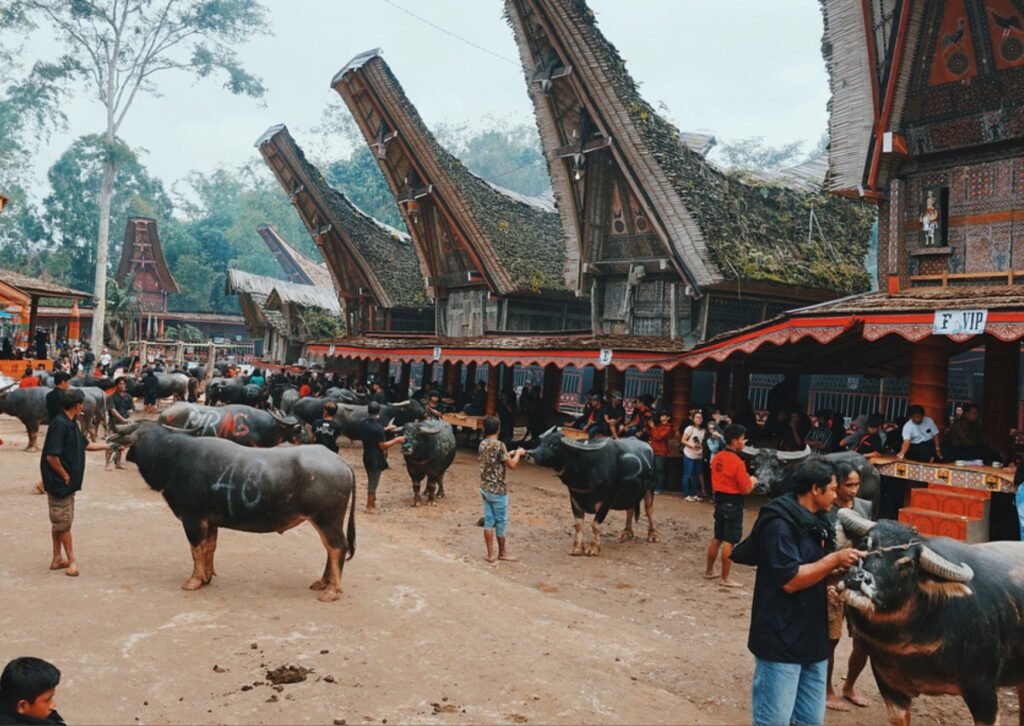Uncategorized
The Importance of Buffaloes in Indonesia’s Culture and Society
The buffalo is considered one of the most valuable domestic animals for agrarian societies in Asia, particularly in Southeast Asia, South Asia, and China. Besides being raised as livestock for meat and milk production, buffaloes are primarily used for plowing rice fields and pulling carts. In Indonesia, the majority (95%) of the domestic buffalo population belongs to the swamp buffalo type. The rest are river buffaloes, which are mainly kept by people of Indian descent in North Sumatra. Consequently, the majority of the buffalo population in Indonesia today, including the wild buffaloes in Ujung Kulon and Baluran National Parks, is descended from the swamp buffaloes that were domesticated in North Vietnam or South China around 5000 years ago.
These swamp buffaloes have since adapted and developed into various local buffalo varieties, such as the Toraja Buffalo (South Sulawesi), Kalang Buffalo (East Kalimantan and South Kalimantan), Moa Buffalo (Southwest Maluku), Pampangan Buffalo (South Sumatra), and Tapanuli Utara Buffalo (North Sumatra). For the people of the Nusantara region, such as the Minangkabau, Batak, Javanese, and Toraja, buffaloes hold significant social and cultural value.
In Sumatra, particularly in the Minangkabau region, the local tradition features a unique architectural pattern known as the Rumah Gadang (Big House) with a distinctive Tanduak Kabau (Buffalo Horn) headdress. The Rumah Gadang belongs to the Minangkabau indigenous community and has a roof that resembles the shape of buffalo horns, with pointed tips. Similarly, the traditional clothing of Minangkabau women, called Baju Tanduak Kabau, is accompanied by a headpiece that forms buffalo horns, hence its name Tanduak Kabau. The Minangkabau people also preserve the tradition of buffalo fighting, symbolizing “a duel of honor.” During such events, dozens of people gather to watch two strong buffaloes face off, and the winner is declared the champion.

In North Sumatra, among the Batak Simalungun community, the buffalo is a symbol of patience, courage, truth, and protection against evil spirits. The Batak Karo people use a white buffalo head ornament made from palm fibers and genuine buffalo horns, believing it represents strength and safeguards against malevolent spirits. The Batak Toba community uses buffalo horns as giant decorations on the front roofs of their houses, symbolizing protection from malevolent spirits.

Throughout the Batak communities, buffalo slaughtering is still performed as a symbolic celebration during traditional ceremonies, such as the Saur Matua and Mangokal Holi rituals (relocating bones from the primary to the secondary graves). Before the slaughter, the buffalo is tied to a pole or “borotan” in the Batak language, and the ceremony is accompanied by the traditional Tor-Tor dance. The buffalo’s meat is then distributed among relatives participating in the ceremony as part of the Jambar Juhut tradition. Similarly, during wedding ceremonies, rituals called Horja Bius involve the slaughter of buffaloes, which play a ceremonial role in the distribution of the Jambar.
In Java, particularly in East Java, there is a cultural festival called “kebo-keboan,” where participants enact the ritual using artificial or fake buffaloes. Some people dress up as buffaloes during the ritual. The choice of buffalo in this ritual is related to the close association between the animal and rice farming activities. Traditional farmers use buffalo power for plowing fields. Though there are alternatives such as using oxen, the buffalo symbolizes strength, patience, and closeness to the earth, making it a more potent icon for the kebo-keboan procession.

In Central Java, the night parade of Satu Suro involves white buffalo herds that surround the Keraton Kartusuro area. The people believe they will receive blessings if they witness the parade directly. Kebo Bule, a buffalo, typically plays a central role in the procession, walking alongside the sacred spear called Kyai Slamet. Kebo Bule serves as the guardian of the sacred object. Moreover, the traditional ceremony of Mahesa Lawung in Gondangrejo, Karanganyar Regency, Central Java, involves burying a buffalo’s head in the Krendowahono forest. This ritual is a generations-old tradition since the Mataram dynasty era and is performed as a plea for safety from God.

In Sulawesi, particularly in the Toraja region, the buffalo fighting tradition, known as “Mapasilaga Tedong,” is an integral part of the extended funeral ceremony of Tana Toraja’s nobility. Death is not necessarily associated with deep sadness; instead, it is celebrated as a joyful event by the deceased’s family and the village before the person moves on to the afterlife. In addition to being part of the funeral ceremony, buffalo fighting is also a form of entertainment for the village community. The Toraja people believe that buffaloes symbolize not only prosperity but also the strength to carry the souls to the afterlife. The more buffaloes sacrificed during a Toraja funeral, the better the deceased’s afterlife will be.

Buffaloes hold a special place in the lives of people, especially farmers, and are essential in sacred ceremonies in various regions. Therefore, the conservation and livelihood of buffaloes are carefully preserved in Indonesia. Due to the deep significance of buffaloes in Indonesian society, various artworks from different regions of Indonesia draw inspiration from the buffalo figure. Examples include wooden carvings and other artworks in our Takala gallery, such as the Flores carving of “The Buffalo Head,” “Batak Tribe Medicine Storage,” and many others. So, come and acquire these items to add to your collection.


